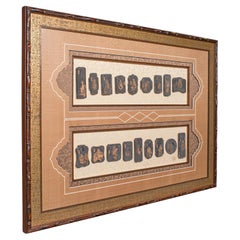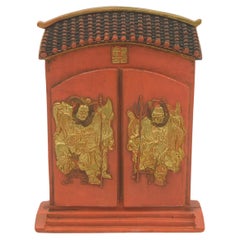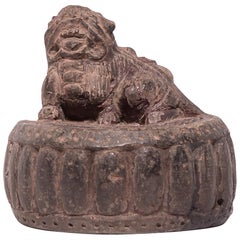Qing Ink Stone
Large Antique Ink Stone Display Set, Chinese, Ornamental Stones, Qing, Victorian
Located in Hele, Devon, GB
This is a large antique ink stone display set. A Chinese, ornamental set of calligraphic stones
Category
Antique Late 19th Century Chinese Victorian Decorative Art
Materials
Stone
$2,460
H 26.78 in W 37.41 in D 1.38 in
Rare Antique Chinese Qing Guangxu Imperial Style Red Ink Stick With Box 19c
Located in Richmond, CA
A rare antique Chinese Qing Dynasty Guangxu period Imperial style marked red ink stick, in the form
Category
Antique 19th Century Chinese Qing Sculptures and Carvings
Materials
Stone
$1,980
H 5.12 in Dm 2.09 in
Recent Sales
Chinese Guardian Fu Dog Ink Stone, c. 1800
Located in Chicago, IL
prepared his ink. A symbol of protection, the lion-like beast bears the features of a shih-tzu, a dog
Category
Antique Early 19th Century Chinese Qing Scholar's Objects
Materials
Limestone
People Also Browsed
Fossilised Skull of Prehistoric Marine Reptile the Mosasaur, 70Million Years Ago
Located in Puglia, Puglia
Upper Cretaceous, about 70-65 million years ago (Maastrichtian)
Morocco
The skull is reconstructed in good proportions with fossil pieces found in a phosphate mine in Morocco.
I att...
Category
Antique 15th Century and Earlier African Natural Specimens
Materials
Bone
$34,921
H 6.3 in W 15.75 in D 5.91 in
Antique Burmese Set of Sixteen Double-Sided Kammavaca or Buddhist Manuscripts
Located in West Palm Beach, FL
An antique Burmese set of sixteen double-sided Kammavaca or Buddhist manuscripts,
written in Bali in red and black lacquer on a gold leaf ground.
This set is accompanied by the ori...
Category
Antique 1890s Scholar's Objects
Materials
Paper
$2,200 / item
H 5.25 in W 26.75 in D 8.25 in
Ancient Egyptian Monumental Temple Sphinxes
Located in London, GB
A pair of monumental limestone sphinxes of Pharaoh Nectanebo I, from the processional avenue of the Serapeum of Memphis, 30th Dynasty, circa 379 - 360 BC.
The sphinxes of the Serape...
Category
Antique 15th Century and Earlier Egyptian Egyptian Figurative Sculptures
Materials
Limestone
Chinoiserie Pagoda
By Renzo Mongiardino
Located in New York, NY
Chinoiserie pagoda. Very decorative Italian painted plaster and wood three-tiered pagoda alla Mongiardino emanating from marine inspired grotto base with four masks issuing water in...
Category
20th Century Italian Chinoiserie Figurative Sculptures
Materials
Gesso, Shell, Wood
Pair of Vintage Patinated Bronze Thai "Singha" Guardian Lions / Foo Dogs
Located in San Diego, CA
Pair of patinated bronze Thai "Singha" guardian lions / foo dogs, circa 1950s. The pair are in very good vintage condition with amazing detail and a gorgeous patina. Each dog measure...
Category
Mid-20th Century Thai Sculptures and Carvings
Materials
Bronze
$1,750 / set
H 10.75 in W 10 in D 5.5 in
Chinese Qing Style Relief Carved Window Panel
Located in Rio Vista, CA
Exquisite Chinese Qing style window panel featuring an intricately carved relief depicting scholars amid pagodas. The carved elm has a beautiful aged patina and fading on the natural...
Category
20th Century Chinese Qing Paintings and Screens
Materials
Elm
Pair of Mid-Century Chinese Ceramic Polychrome Foo Dogs
Located in San Diego, CA
Great pair of mid-century polychrome glazed ceramic foo dogs from China, circa 1950s. Great detail with each dog holding a coin medallion in its mouth and a beautiful color combinati...
Category
Mid-20th Century Chinese Mid-Century Modern Animal Sculptures
Materials
Ceramic
Panoramic Trompe L'Oeil Modern Sideboard Server Cabinet by Egg Designs
By Egg Designs
Located in Bothas Hill, KZN
This modern sideboard server has a panoramic Trompe L'Oeil design on the doors, the panoramic Trompe L'Oeil shows a tropical vista of floral, shrubs, tress & vines with a mountain ra...
Category
2010s South African Modern Sideboards
Materials
Steel
$9,995 / item
H 31.89 in W 95.67 in D 20.48 in
Chinese Antique Monumental Buddhist Wooden Pagoda Tower, 70 Inches
Located in South Burlington, VT
China antique monumental Wooden Pagoda, total height is 70 inches, hand carved and hand painted wood, seven hexagonal sections plus finial, late Qing dynasty (1644-1911)
This is a m...
Category
Early 20th Century Chinese Qing Sculptures and Carvings
Materials
Wood
Large Antique Victorian Two Rifle Rack / Wall-Mounted Gun Display Rack with Box
Located in Lisse, NL
Unique and large Victorian rifle rack with width open box at the bottom.
This highly decorative and good condition gun rack for wall mounting could look great above your fireplace...
Category
Antique Late 19th Century European Victorian Decorative Art
Materials
Brass
$1,836
H 34 in W 31 in D 3.5 in
1950s Le Corbusier Jeanneret Perriand LC1 Basculant Lounge Chair Stendig Label
By Pierre Jeanneret, Charlotte Perriand, Thonet, Le Corbusier
Located in Philadelphia, PA
This is an original 1950s LC1 Basculant Sling Lounge Chair, initially designed by Le Corbusier, Pierre Jeanneret and Charlotte Perriand in 1929. This example is marked with a Stendig...
Category
Vintage 1950s German Modern Lounge Chairs
Materials
Steel
$6,000
H 25.5 in W 23.5 in D 22.5 in
A superb Minangkabau red-enamelled and brass wedding crown or 'Suntiang'
Located in Amsterdam, NL
A Minangkabau red-enamelled and brass wedding crown or 'Suntiang'
A Minangkabau red-enamelled and brass wedding crown or 'Suntiang'West Sumatra, Minangkabau, probably 1st half 20th ...
Category
Mid-20th Century Indonesian Metalwork
Materials
Brass, Enamel
$3,431
H 18.67 in W 13.78 in D 5.91 in
Italian Provincial Marcucci Deruta Blue and White Scalloped Faience Wall Plate
By Deruta
Located in Elkhart, IN
A beautiful French Provincial style hand painted blue and cream faience pottery wall plate featuring floral designs.
By Marcucci for Deruta
Italy, Late-20th Century
Measures: 5.25...
Category
Late 20th Century Italian French Provincial Decorative Art
Materials
Faience, Pottery
$316 Sale Price
20% Off
H 6.5 in W 6.25 in D 1.25 in
English Chinoiserie Style Twenty-Six Piece Silver Toilet Service
By Lionel Alfred Crichton 1, Richard Comyns, Carrington & Co
Located in London, GB
This twenty-six piece silver toilet service was created in the early 20th century, after a model made in London between 1673-1682. The original set is on display at the Sterling and ...
Category
Early 20th Century English Chinoiserie Sterling Silver
Materials
Silver
$62,037 / set
H 20.08 in W 13 in D 11.03 in
DRUANTIA Large Tassel Jacquard Cushion - Verde
By House of Hackney
Located in New York, NY
In Celtic mythology, Druantia is known as the Queen of the Druids and goddess of oak-groves. Now you can bring a touch of her ancient magic home with this charming jacquard cushion. ...
Category
21st Century and Contemporary British Pillows and Throws
Materials
Jacquard
Giant 7.6 Ft Golden Citrine Geode Wings – Museum-Grade Pair, Natural Masterpiece
Located in Ametista Do Sul, BR
Bookmatched Giant Citrine Geodes Set as Wings with High-Grade Golden Orange Druzy – Considered the Best X-Large Citrine Wings Worldwide
▫️ Description
Giant in size, fabulous in be...
Category
2010s Brazilian Natural Specimens
Materials
Crystal, Quartz, Rock Crystal
$92,000 Sale Price
20% Off
H 91 in W 85 in D 20 in
Get Updated with New Arrivals
Save "Qing Ink Stone", and we’ll notify you when there are new listings in this category.
Qing Ink Stone For Sale on 1stDibs
At 1stDibs, there are many versions of the ideal qing ink stone for your home. A qing ink stone — often made from stone, wood and fabric — can elevate any home. Your living room may not be complete without a qing ink stone — find older editions for sale from the 19th Century and newer versions made as recently as the 20th Century. A qing ink stone is a generally popular piece of furniture, but those created in Art Deco styles are sought with frequency.
How Much is a Qing Ink Stone?
A qing ink stone can differ in price owing to various characteristics — the average selling price 1stDibs is $1,480, while the lowest priced sells for $328 and the highest can go for as much as $6,925.
More Ways To Browse
Red Stone Carving China
Ammo Box
Amsterdam Grandfather Clock
Anchor Bottle Opener
Ancient Roman Glass Bottle
Anco Bilt
Andre Arbus Book
Andre Fau
Andrea Della Robbia
Andreas Zadora Von Gerlof
Angel Figurine Decorative Object
Angel Font
Angel Putti Sculptures
Angel Table Marble
Anglo Indian Coffer
Angraves Cane
Animal Garden Seat
Anker Hoffmann


